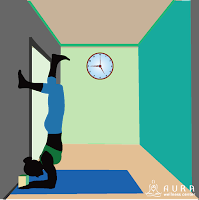By Dr. Paul Jerard, E-RYT 500
Some students ask, "What are the values of Yoga props?" If you are going to teach or perform postures and movements, then it is important to have an assortment of props
available to make routines safer and more enjoyable. There are multiple
benefits from using props that include:
• Blankets
• Wooden blocks
• Mats
• Pillows
• Walls
• Towels
• Slant boards
• Balls
• Straps
• Bolsters
• Chairs
Value 1: Learning Yoga With Affordable Household Items
When you are beginning to practice Yoga, you can use household items that make it easier to perform a particular pose that is difficult. You can use a necktie instead of a specialized strap, and you can use a small area rug as a mat. As you progress in your Yoga practice, you can begin to buy professional props.
• Blankets
• Wooden blocks
• Mats
• Pillows
• Walls
• Towels
• Slant boards
• Balls
• Straps
• Bolsters
• Chairs
Value 1: Learning Yoga With Affordable Household Items
When you are beginning to practice Yoga, you can use household items that make it easier to perform a particular pose that is difficult. You can use a necktie instead of a specialized strap, and you can use a small area rug as a mat. As you progress in your Yoga practice, you can begin to buy professional props.
Value 2: Preventing an Injury While Posing
If you have a back or knee problem, then place a folded towel, small pillow or folded blanket under your knee or back to prevent an injury. You should never try to force yourself into pose because it can damage a joint or strain a muscle, requiring a long recovery time.
Value 3: Reducing a Student’s Boredom
When you teach yoga, you will want to have a wide range of classes for different levels of students. If you have props such as slant boards or balls, then your students can perform challenging physical routines. Students who have advanced to a higher level of coordination and strength will appreciate performing a fun routine that uses a ball.
Value 4: Giving a Student Confidence
Some students lack confidence while trying a new Yoga pose, but if they have a prop such as a strap or necktie, then they will have leverage to help with lifting a leg higher slightly. After your student notices how much easier it is to perform a difficult pose with a prop, they may have enough confidence to attempt challenging physical routines.
Value 5: Maintaining Balance During Yoga Postures
If you are concerned about losing your balance during a pose, then you can lean against a wall. Select a section of a wall that is away from furniture and that doesn’t have any artwork. For additional protection, you can push mats or blankets against the wall in case you fall while creating a one-legged Yoga pose.
Value 6: Protecting the Nerves In Your Neck
It is essential to protect the sensitive nerves in your neck while performing yoga postures on the floor. Make sure to place a small pillow, folded blanket or rolled towel underneath your neck until your feel comfortable. While you might not notice any discomfort in your neck right away, if you don’t protect the nerves in this region, then you will experience pain the next day.
Value 7: Making Yoga Easier for Senior Citizens
As a senior citizen, you may find it difficult to stand and balance for long amounts of time, but fortunately, by using a chair as a prop, you can enjoy many arm, shoulder and neck movements. If you select a chair that is sturdy, then you can also use it as support while standing and performing poses.
Value 8: Support During Complex Moving Yoga Poses
If you have advanced to performing complex poses in a supervised class, then you may need to use a block to maintain your pose. You can find specialized durable foam or wooden blocks in a variety of shapes and sizes that you can use while performing a handstand or headstand to avoid falling over as you learn a new Yoga posture.
© Copyright – Aura Wellness Center – Publications Division
Please feel free to share our posts with your friends, colleagues, and favorite social media networks.
Please feel free to share our posts with your friends, colleagues, and favorite social media networks.








